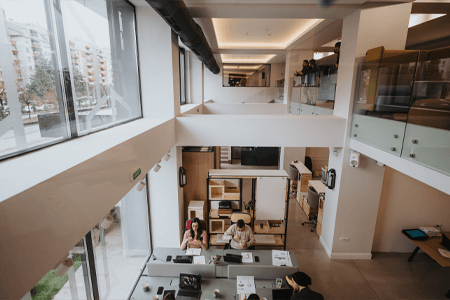Improving Workplace Productivity with IoT Sound Monitoring
Workplace Wellness

Office providers face challenges with disruptive noise affecting productivity. cThings deployed sound sensors and a digital twin to optimise soundproofing, saving tens of thousands of pounds and enhancing workplace conditions.
Our brief
A leading office space provider approached cThings to help resolve an issue with poor sound conditions within their latest flagship building. The company had invested more than £18 million constructing and furnishing the building, with an aim to create an industry-leading office space for pharmaceutical firms.
Shortly after the opening of the building, it became apparent that sound levels within the building were causing a poor working environment for staff. The poor acoustic conditions resulted in meeting rooms being perceived as unsuitable due to background noise and causing employees to report a lack of productivity due to the disruption.
Our customer had conducted several acoustic surveys in an attempt to identify the cause of the issue and taken action to retrofit sound proofing. After the improvements were made, however, the building occupants didn’t notice any change and complaints of disruptive noise continued.
The customer requested cThings to deploy sound monitoring equipment to collect and analyse the data before and after the installation of new sound proofing measures, in order to determine the effects. Another aim would be to identify problem areas within the building in order to help determine the specification of future sound proofing modifications.
Our solution
cThings deployed Sound Sensors throughout the building. These included the meeting rooms, open spaces, and corridors. The sensors are battery powered and use wireless LoRaWAN communication. This meant the installation, setup and commissioning were completed at low cost and within a day.
Once the sensors were configured to send data to the cThings Cloud, this allowed us to create a digital twin of the building using our flexible hierarchy, enabling us to model the acoustic conditions within the building. The customer also benefited from being able to create and download reports to undertake their own analysis.
Using the cThings Cloud empowered the customer to visualise and understand the conditions of their buildings, before and after installation of additional sound proofing. For the first time, the customer had numerical evidence to determine the effects of the sound proofing.
"The cThings Cloud and sound sensors allowed us to understand the problems within the building using empirical data. This proved crucial in helping us to resolve the issues and improve the working space we provide."
The results
Following the installation of the sensors and the implementation of the dashboard, the customer was able to identify areas of the building that were suffering from the amplification of background noise.
Once these areas were highlighted, the customer targeted these areas for additional sound proofing. With the assistance of external consultants using the collected data, the customer was able to identify high decibel areas of the building, which in turn were causing other areas to suffer from noise pollution by contagion. These areas were also targeted with the roll-out of sound proofing. At the conclusion of this installation the acoustic performance of the building was significantly improved with less than 50% of the estimated quantity of sound proofing needing to be installed.
The customer estimates that this approach saved them over £35,000 of sound proofing material. They were also able to use this data to demonstrate to the building occupants that the sound proofing had resolved the issue and the complaints regarding background noise ceased.
The benefits
Low-cost solution
The sensors are battery powered and use wireless communications, which leads to quickly deployed and low cost projects
Cost savings
The sensors can be used to help plan sound proofing or the acoustic performance of buildings. Helping to reduce the cost of retrofitting buildings and to assist in the design of new buildings.
Key performance metrics
The sensors record key parameters such as peak or average sound levels allowing for detailed analysis and to help create the best environments for offices, homes, and public spaces.
Additional sensors
The cThings sound monitors also features secondary sensors to help determine the environmental conditions within the building (temp/humidity/light) and occupancy. Allowing you to understand your building in more detail.